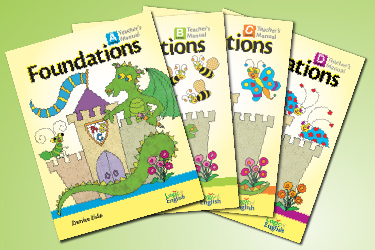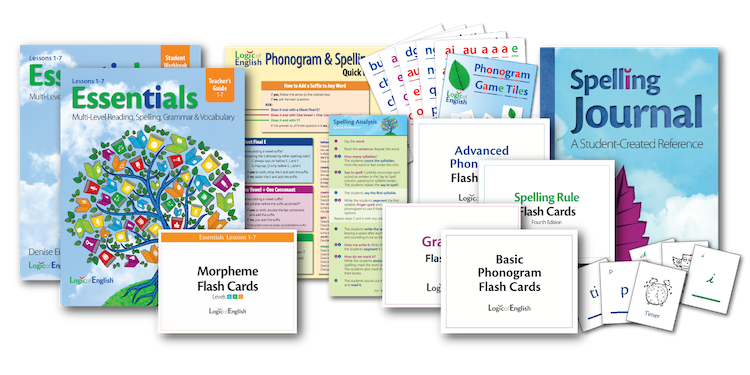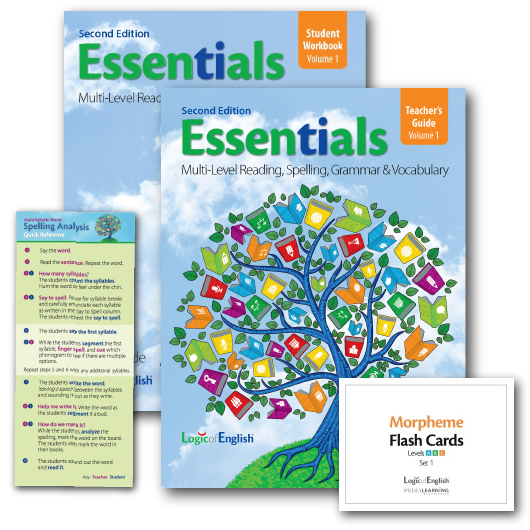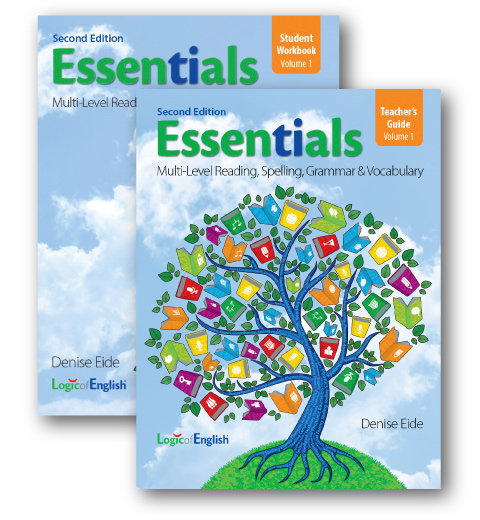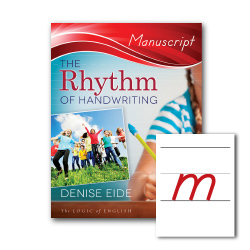UPDATE: The version of Logic of English Essentials I reviewed has now been replaced by newer versions, which is just as wonderful, I hear, but just broken up into different smaller books. You can still find the version I reviewed at the Scratch and Dent/Discount page.
 |
You know know you're an eclectic homeschooler when you are moving towards a more Charlotte Mason-inspired homeschool method for the coming year, yet unexpectedly find yourself embracing the quite non-CM Essentials 2nd Edition curriculum by Logic of English for one simple reason: It is the best program you've seen to meet the English Language Arts needs of your children (and, by chance, a tutoring student, too!)
Honestly, I could not be happier with how well-timed our opportunity to review Essentials has proved in our lives. My child who needs the program most is just the "right age" for it. My other children are at places they can benefit from Essentials as well. Plus, by chance, my tutoring student is also excited about Logic of English. Thus, for the duration of this "school year" and into next, I look forward to how Essentials can help me help the children I teach with:
- phonics,
- reading,
- spelling,
- high-frequency words / sight words,
...and, perhaps, most importantly, making sense of the parts of English Language Arts that they struggle with!
Why We Need Logic of English
If there is one thing any educator knows, it is that every child is different. So, finding ways to meet the needs of a variety of students can be a challenge. Something I am loving about Logic of English is that it is adaptable to the learning styles of children of various ages and abilities.
For example, my oldest uses a rich conversational vocabulary and buzzes through chapter books on his own. However, he is still developing oral reading skills and does not have a strong enough command of some phonics and syllabication to tackle "big words" when reading aloud. His spelling and grammar skills are less than stellar, and his understanding of prefixes, suffixes, root words, etc. is rudimentary. (We had begun focusing on these before, but fell away from doing so.)
Essentials is already helping me help my oldest to fill in some gaps in spelling, grammar, and vocabulary. He agrees that such gaps need to be filled, but does not like putting his hand-to-paper much. Oral activities and games, included in Essentials work well for him, and I truly believe that once his grammar and spelling improve, he will come to love writing as much as he loves reading chapter books.
My middle child, we think, has dyslexia. She disproves all of those folks who say, "If you simply read to a child daily from birth, surround the child with a rich environment, and go at a child's pace, the child will practically teach herself to read." Nope. Not with her. She has been read to multiple times a day since before she was born, has lived in a rich learning environment her entire life, and has started, paused, re-started, plateaued, etc. for years when it comes to English Language Arts. In fact, my daughter has not only not taught herself to read, but she also struggles significantly with other facets of English Language Arts and has taken to crying over the past year, wondering why "everyone else gets it so easily, and I don't." It breaks my heart, and I am determined to guide her through her struggle. So, as much as I like "natural learning", in my daughter's case, I have come to admit there is a need for 1:1 systematic, direct teaching that keys into relationship and fun through learning games, too. Essentials offers all that! I truly believe Essentials may help me to finally help my daughter overcome her lack of progress in ELA.
Likewise, I can see it working with my youngest child, who is only five years old and is quite typical to same-age peers as far as his English Language Arts skills go. Technically, he is young for Essentials, which is geared to children ages seven and up, and would do well to use Foundations, which is geared for children ages four to seven, but since our experience so far is that he enjoys light use of Essentials, we'll stick with it.
Bonus: One day, my tutoring student was supposed to bring some work to our session together, but did not. I had forgotten to bring extra things to do with her myself, but had some of my Essentials materials in my bag since I'd been using them with my own children outside earlier in the day So, I ended up sharing part of Essentials with my student, a fifth grader, who is at a lower level when it comes to ELA. She loved hearing that, according to research, there are 74 basic phonograms (letters or letter combinations that represent a sound) and 31 spelling rules that can explain how to spell 98% of all English words.
My student happily took the Essentials placement test orally and on a blank notebook page. Since then, for the past two weeks, she has been eager and succeeding, buzzing through Logic of English concepts well enough that I plan to begin using the entire program all out with with, purchasing a single use/family license copy of the electronic student workbook for the program for my own children to use and letting my tutoring student use a hardcopy student book. (The e-book is quite reasonable and will let me print out student pages for each of my children at their levels as they progress with the program.)
Yes. Having spent a little over a month with Logic of English's Essentials 2nd Edition, I have become familiar enough with it to be confident that it is a superb tool for helping children, like mine and my tutoring student, grow in understanding of spelling, reading, vocabulary, and grammar so that they can become strong readers and communicators.
Better still, because Essentials is designed to teach students at multiple levels of learning, it can be a one-stop source for children ages seven and up. (Yes, as I previously mentioned, my youngest is only five, and, therefore might do better with the Foundations program that is geared for children ages 4-7, but since he likes learning alongside his siblings, we are sticking to the one-size-is-adaptable-to-all Essentials.) So far, I am finding Essentials an ideal fit for a variety of personalities and ages, including struggling learners.
Just What Is Essentials and Why Does It Offers So Many Components
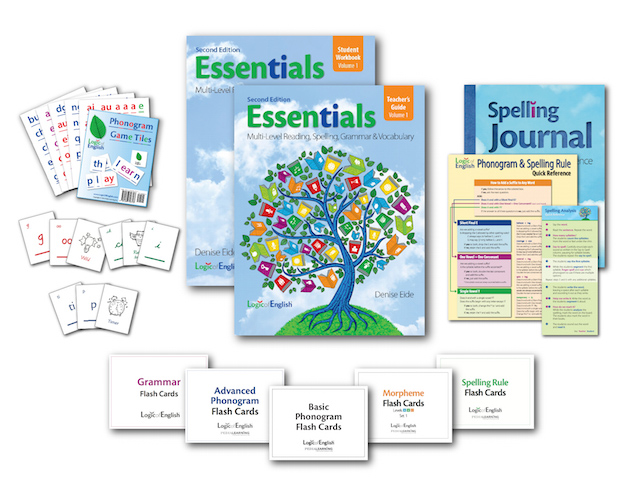
In brief, Essentials 2nd Edition is a solid program that comes with everything you might need to logically teach reading, spelling, grammar and vocabulary to students ages 7 and up. At first glance, it is such a full package that it might make your head spin. However, there is no need for alarm. That same fullness that could appear daunting, is actually an easy-to-implement, adaptable program that includes many well-organized parts designed to meet the needs of multi-sensory learners and their educators.
In the Essentials package that I received were:
The Essentials Teacher's Guide, 2nd ed., Volume 1
This 632-page hardcover tome may resemble a heavy, dreaded textbook at first glance, but - trust me one this - it is actually a comprehensive, well laid out, helpful, step-by-step resource that can guide you through teaching three levels of English Language Arts in a systematic way or through adapting to your own style and needs.
The beginning of the Teacher Manual includes a thorough overview of the program and step-by-step instructions on how to use the guide. There is also a placement test to help you decide which level of work to begin with each of your students. I found this quite helpful in placing each f my own children, as well as my tutoring student, at appropriate levels within the program.
The rest of the manual consists primarily of 15 scripted lessons broken down into five 30-minute-to-an-hour chunks, which are meant to take you through one semester's worth of learning, but will take my family a bit longer, since we tend to study in 10-20 minute chunks only. The lesson chunks, as they are written, include:
- Day 1: Essential Concepts - New phonograms are introduced and old ones are reviewed.
- Day 2: Building Words - Phonograms are reviewed through games, writing activities, and journaling. A leveled spelling list activity is also used.
- Day 3: Words in Context - Phonograms, spelling, spelling rules, and grammar are focused on.
- Day 4: Words in Action - There is more review, concentrating on vocabulary. You also have the option of incorporating Essentials Reader lessons.
- Day 5: Check Your Understanding - This day starts with a review using Grammar Flash Cards. Some vocabulary work follows before time is spent checking understanding of concepts and skills learned in the five-day lesson.
Each of these lesson segments is scripted. However, a well-laid out design that includes teaching tip boxes, options for further practice, icons to indicate when to use student workbooks, color-coded sections for each of the three learning levels included in the curriculum, etc. allow those, like me, who tend to feel boxed in by scripted lessons to easily look at each manual page and quickly decide how to best deliver key points to match my teaching style and my children's learning styles I truly feel that the way the Teacher's Guide is formatted makes teaching Essentials concepts easy for both novice educators and practiced ones.
The guide also ensures that teachers can make learning fun for students. For, in the guide are instructions for a wide variety of games and hands-on activities that can easily be played with the cards included in the program materials. To me, these make the program - taking it from a dry, "booky" approach, to one that children can latch onto. For, if your children are anything like mine, they thrive when using short, fun games to reinforce their learning. In fact, when I asked my oldest what he thinks about the curriculum, one of the first things he said was:
I like the games, especially when I played them with just you, because me versus one is easier than me versus four.
Likewise, my youngest said:
I liked (this curriculum) because of the games! The dragon game and the other card games were fun.
My middle child concurred with her siblings, saying:
What I liked about (the curriculum) was that you were able to play games with it.
Undoubtedly, the games make the curriculum for my children!
The EssentialsStudent Workbook, 2nd ed., Volume 1
This "booky" part for students is a softcover, 320-page resource with plenty of white-space on each page and lines wide enough for students to easily write on. It comes in both a physical softcover version or as a printable e-book, so your family can easily use it with however many children you have.
I was especially pleased that my middle child finds the workbook non-threatening. With its simple text, large writing spaces, and ample white-space, it is easy on her eyes.
(Update: This workbook ha since been replaced by several smaller workbooks, beginning with this one.)
This handy 72-page paperback has spelling hints printed in it as well as sections for a student to keep track of words that use each of the 33 English sounds that can be spelled more than one way. A unique set up helps students master commonly misspelled words by providing them with a systematic way to pinpoint areas of difficulty, recognize spelling options for specific sounds, and identify the correct spelling of words.
A Collection of Tiles and Cards
Tiles and cards, printed on heavy, laminated cardstock, act as hand-on helps for students and include:
- Basic Phonogram Flash Cards - Seventy-four 4.5" x 6" cards contain single-letter and multi-letter phonograms along with sample words and spelling aids that offer you quick reference.
- Spelling Rule Flash Cards - Forty-one (Update: now 42) 4.5" x 6" cards help you discover the rules that will allow you to spell 98% of English words.
- Advanced Phonogram FlashCards - Forty-six (Update: now 48) 4.5" x 6" cards help you unlock the spelling and reading of thousands of additional words.
- Grammar Flash Cards - Eighty-three (Update: Now 84) 4.5' x 6" cards cover parts or speech, punctuation rules, capitalization rules, contractions, and conventions for writing numbers, providing sample phrases and sentences for ready reference.
- Morpheme Flash Cards, Set 1 - One-hundred-nine color-coded cards (which can also come as a pdf download or for use on a tablet) help you see how roots, prefixes, and suffixes come together to give meaning to English words.
- Phonogram GameCards - Seventy-four 2.25" x .5' phonogram cards and 14 action cards come in a deck that can be used to play any number of games.
- Phonogram Game Tiles - One-hundred-thirty color-coded tiles can be used for a variety of spelling games and exercises.
- Phonogram and Spelling Rule Quick Reference - A full-color, at-a-glance chart offers you information on prefixes, suffixes, and more, including lists of the 31 spelling rules, 74 basic phonograms, and 46 advanced phonograms that are used in the program.
- Spelling Analysis Card - This handy reference tool outlines the program's step-by-step the process for dictating and analyzing spelling of words.
I also received the supplemental Optional Essentials Readers Set package, which is designed for older students (age 8+) who are still struggling with reading, and correlates specifically with the phonograms taught in each lesson Essentials 2nd Edition. This add-on includes:
- The Essentials Reader - Thirty-one high-interest passages include tongue-twisting riddles, classic folk tales from around the world, and interesting non-fiction pieces on such topics as sports, science, technology, biographies. The Reader currently comes in two formats: a black and white version designed for printing in booklet form and a full color version for using digitally.
- The Teacher’s Guide - A 102-page downloadable full-color pdf guides you in how to approach pre-reading, analysis, comprehension, note-taking, vocabulary, composition and other extension activities.
- A Student Activity Workbook - A 204-page, black-and-white downloadable pdf offers response pages for the dozens of activities contained in the Teacher's Guide.
My youngest got a kick out of reading the tongue-twisters in the Readers with me and, then, challenging his Daddy and siblings to repeat them.
But How Can I Manage All The Parts?
All the Essentials components may seem like a lot to keep track of, but each physical resource or pdf download can easily be placed together in a canvas or plastic tote with a pencil, a notebook, paper, a white board, and dry-erase markers to become your go-to one-stop source for teaching English Language Arts. Some of the resources, such as the game cards and flashcards, could also be purchased and kept in a baggie to be used as stand alone helps to compliment other ELA approaches.Personally, I just kept our Essentials books and workbooks on a shelf alongside a large zippered storage bag that I filled with all the cards and tiles, wrapped in rubber bands. Then, when we studied at home, the kids could fetch our materials, or if I was taking learning outside, I could pop what I needed into a canvas bag or backpack. Easy peasy!
Does It Really Work?
As far as I am concerned, every child is unique and, therefore, all children require learning resources tweaked to their needs and styles. In my experience so far, Logic of English's well-researched and designed approach makes it easy to adapt to the needs of both on-level and struggling learners. A balance of oral, reading, and written work presented through games and book work appeal to different learning styles, while a scientific approach to the actual logic behind why English works the way it works helps those using the program unlock spelling, reading, vocabulary, and grammar skills.
When we first began using Essentials, I gave each of my children the placement test, which illuminated their gaps and strengths (and excited my daughter when she realized she was actually stronger at some skills than her brother who whizzes through chapter books while she struggles to decode simple words!) Then, based on the results, I adapted the pre-lessons detailed in the Teacher's Guide, for each of my children individually, one-to-one. Then, we tried Lesson One as a group and moved on from there, sometimes learning together and sometimes learning one-to-one, not hitting every part of every lesson, but ensuring my children get each key concept before moving on.
Through doing so, I have already seen positive growth in each of my children's English skills and have also landed on a program that will work for a tutoring student of mine.
Our "Bottom Line"
Obviously, my bottom line is that Logic of English is the best program I have come across to date for unlocking spelling, vocabulary, grammar, and reading with one curriculum that can be tailored to students at a variety of ages and stages.
When I asked my five-year-old about Logic of English, he said:
I liked it ... because of the games. I liked that I could sound out words by myself. I can spell. I want to keep trying it. I like it best with my brother and sister.
My eight-year-old who wants everything to come super easy and is the one who has actually come to ears over how difficult English can be for her is now smiling during English lessons and has said:
I guess I will keep learning it just so I can learn English... how to read and write and spell better. It's helping me, and I want to give it more chances. I like the games we are able to play with it.
My ten-year-old, who is a hard sell on anything "schooly" said:
I don't love it, because I don't like spelling and writing, but compared to other things I have used for spelling I like it. It's not quite as boring because there are card games we can play. The lessons are short and I like the cover with the picture of the tree. I told Mom that we could finish it, so I never have to study spelling again because I know it can teach me how to spell. She told me it can take years to finish all its level, and I said, "Okay, can we do this fast." I want her to skip parts or let me do it for hours and hours until it is done.
We tried doing the lessons with just Mom and me and, then, we tried them together with my brother and sister. I prefer them just by myself, because my brother and sister slow me down. Also, in games, me versus one is easier than me versus four. I'd rather play with just Mom, but sometimes playing together is okay, too.
So, you can see that my children, even if they do not love Logic of English find value in it. I am glad they do, for I have found Essentials to be a solid curriculum, thorough curriculum that provides detailed instruction and in-depth learning using high quality components. The games included in the curriculum engage my children while reinforcing concepts that have been taught. The layout of lessons allow you to slow down to help struggling learners with particular concepts or buzz through pieces that more advanced learners already get.
Why Logic of English Might Make Sense for You
Essentials 2nd Edition is a thoroughly-researched and well-thought out presentation of the English language which provides solid phonetic instruction at three different levels and can, therefore, be used for several years of instruction, or with several students. The program also:
- offers and intergrated foundation in phonics, spelling, grammar, reading, and vocabulary, which means you do not need separate English programs for separate skills nor do you need to figure out how to teach x, y, or z on your own.
- appeals to children who do not like busy, book work, since some of the work is done orally, some in a workbook, and much through games and activities.
- provides consistent review throughout the material so lessons are not learned and forgotten.
- is flexible. The program is written with an excellent pacing guide and lays scripted lessons out for you on a 5-day schedule per lesson. Color-coding, call-out boxes, and other well-designed portions of the teacher's book, as well as the plethora of learning cards and tiles, however, make the program easy to adapt to fit your schedule and the individual needs of each child you are teaching.
Currently, the complete Essentials 2nd Edition package sells for $198 ($23 dollars off its usual price), I truly feel it is worth the investment for those who have struggling learners or multiple children since it is such a well-laid out, effective curriculum which can cover three years of learning. Those with students who are less in need of the complete program or who are on a budget, however, can also benefit from purchasing individual curriculum components, such as flash cards or game cards to add learning fun and reinforcement to existing studies.
As if I have not made it clear already, as both a home educator and a tutor of brick-and-mortor school students, I appreciate Logic of English since it is a solid program that lives up to its name. It logically presents English in a way that parents, teachers, and tutors can help students move along with confidence, gaining skills and understanding.
You might want to check Essentials out if you are:
- a family, tutor, or teacher with students aged seven to adult.
- someone who likes to blend traditional book learning with hands-on games and activities.
- an educator who needs step-by-step scripted lessons (or who like to browse such things, but to make lessons your own) .
- a person who get frustrated by English spelling and wants to know why English words are spelled the way they are.
- someone seeking a logical way to teach spelling, grammar, and vocabulary to students in grades 2-6 - using one multi-level approach.
- an educator with older struggling readers and spellers.
- a parent or teacher of a dyslexic student.
Truly, I think the program could be a good fit for just about any home, tutor, or classroom teacher, except those that are vested in only using living books, those who embrace a complete unschooling approach; those who do not wish to invest time in direct 1:1, small-group, or large-group teaching (preferring to have students learn on their own or with computer-based programs); and those who do not like keeping track of multiple cards or letter tiles.
Learn More
Who does not like FREE RESOURCES?! Logic of English offers a host of FREE handwriting pages, spelling lists, charts, and more on their website.
They also offer packages for cursive writing:
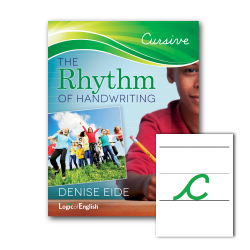
Get social with Logic of English at:

Click through to read what 100 Schoolhouse Review Crew families thought about a variety of Logic of English programs.
Have you found an all-in-oneEnglish curriculum you can use with different learners at different levels? If not, this could be it!





